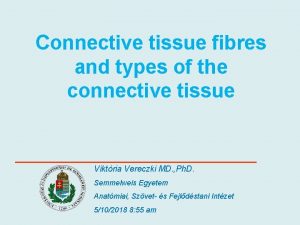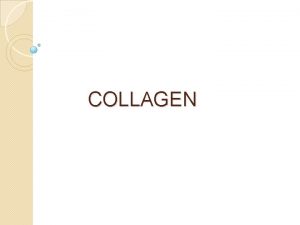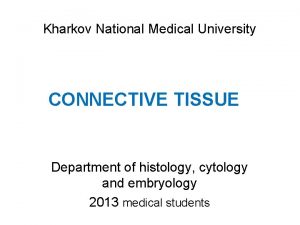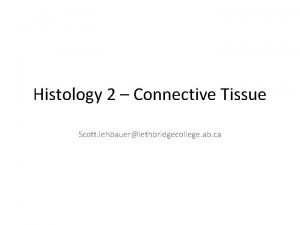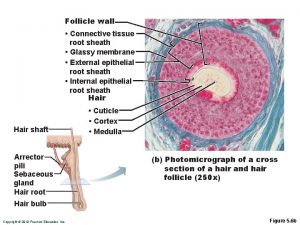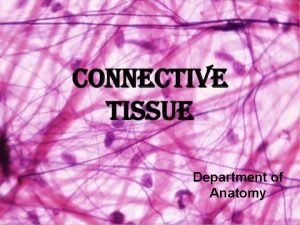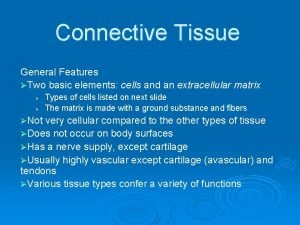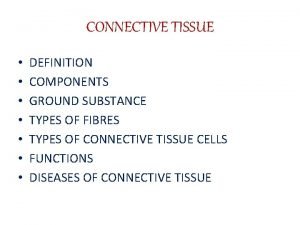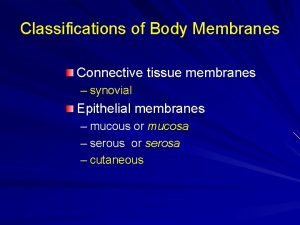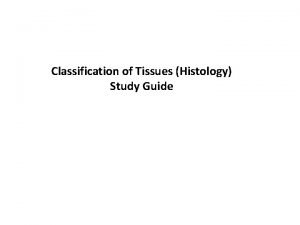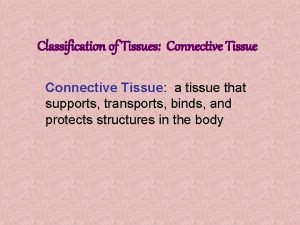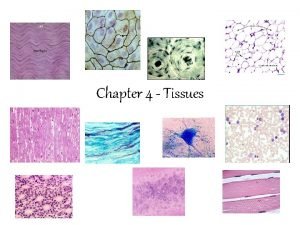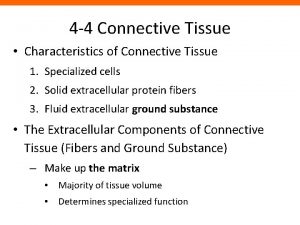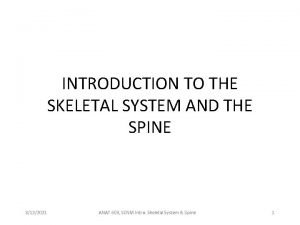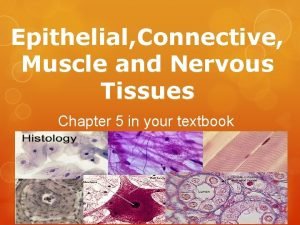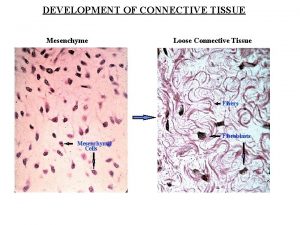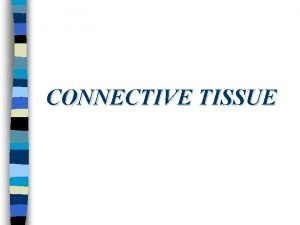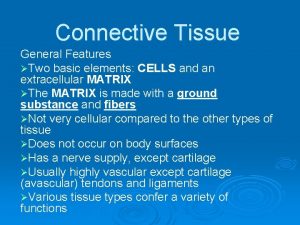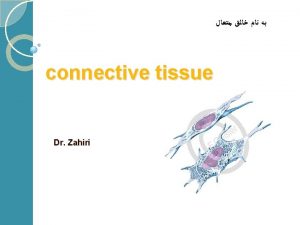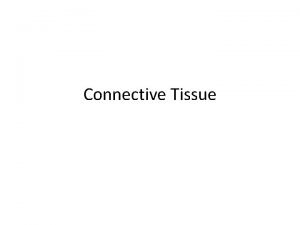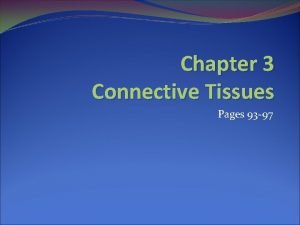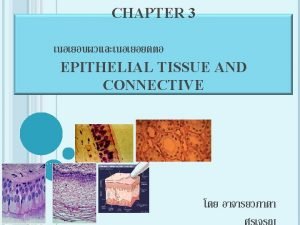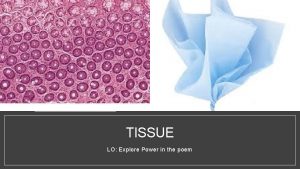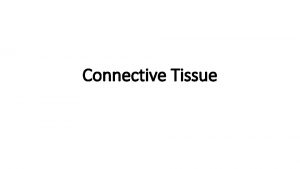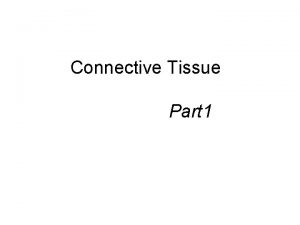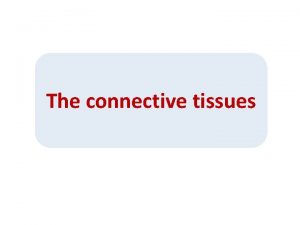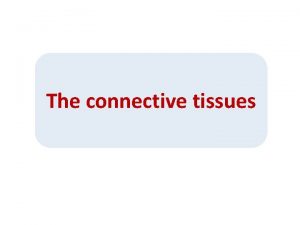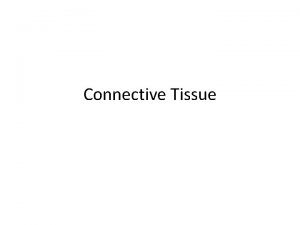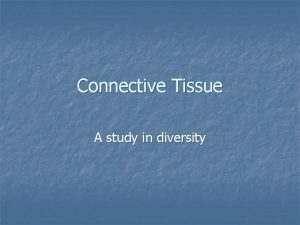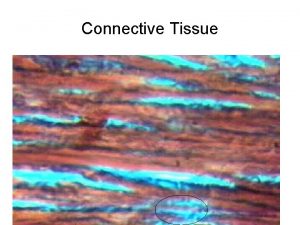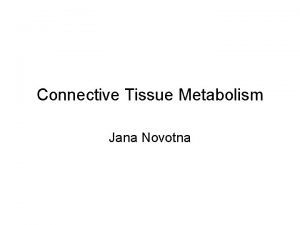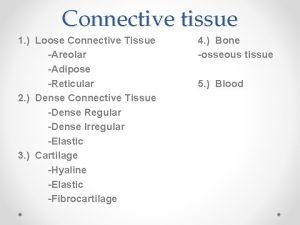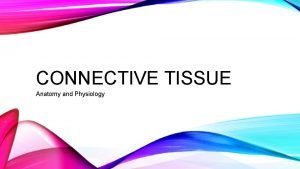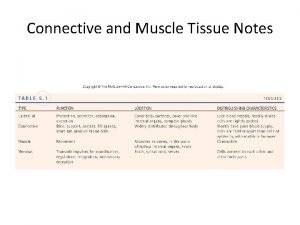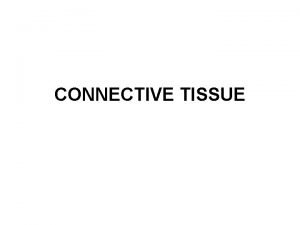COLLAGEN Collagen Major component of most connective tissue
































- Slides: 32

COLLAGEN

Collagen �Major component of most connective tissue �~25% of the protein of mammals �In humans 28 Distinct types of collagen Made up of 30 Distinct types of Polypeptide chains Each encoded by separate gene

Type I Type Location Types of collagen XV Skin, Bone, Tendon(non Associated with collagen to Location cartilage) basement membrane II Cartilage, Vitreous humor XVI Many Tissues III Extensible conn. Tissue(skin, lung, vascular system XVII Epithelia, Skin hemidesmosomes IV Basement Membrane XVIII Close structural homologue of XV V Along with Type -I XIX Rare, Rhabdomyosarcoma VI Muscle XX Corneal epithelium VII Dermal epidermal junction XXI Many Tissues VIII Endothelium XXII Tissue Junctions IX Along with type -II XXIII Limited in tissues transmembrane and shed forms X Hypertrophic cartilage XXIV Developing Cornea, Bone XI Along with type-II XXV Brain XII Along with type-I XXVI Testis, Ovary XIII NM Junction and Skin XXVII Embryonic Cartilage XIV Along with type-I XXVII BM Around Schwann cells

Mature Collagen ( Type 1) � The entire molecule is triple helical � ~1000 AA � Each polypeptide subunit (α chain not α helix) is twisted into left handed polyproline helix and 3 residues per turn � 3 of these α chains are then wound into a parallel right handed superhelix, forming a rod like molecule (1. 4× 300 nm)

� The repeating structure, represented as (Gly-X-Y) is an absolute requirement for the formation of triple - Glyhelix – X – Y – Gly – X – Y Amino Acid sequence �X = mostly proline � Y = mostly hydroxyl proline / sometimes hydroxylysine ◦ Hydroxyl derivatives on Y positions because of specificity of prolyl/lysyl hydroxylase

What is glycine residue at every 3 rd position? � Glycine is the only AA small enough to be accomodated in the limited space available in contral core of triple helix

X & Y Positions � Proline / hydroxyproline confer regidity on collagen molecules � Hydroxyproline & Hydroxylysine are result of post translational modification Can be further modified by addition of • Glactose • Galactosyl-glucose • Through O-Glycosidic limkage (unique glycosylation site of collagen)

Staggering of αchains: � 3 polypeptide chains are staggered so that Gly-X-Y � Resides from the three polypeptide chains occures at similar level � And so –NH of ‘Gly’ makes strong H-bond with –CO of an ‘X(pro)’ of neighbour chain


Quarter Staggered alignment � Collagen types (only rod like fibers) are assembled by lateral association of these triple helical units into fibrils (10 -300 nm diameter) in a ‘Quarter staggered’ alignment � Means, each triple helix is displaced longitudinally from its neighboure by slightly less than 1/4 th of its length

Fibril – � many fibrils associate into thicker FIBER (1 -20μm diameter) In some tissues (like tendons) fibers associates into even larger bundles, with diameter of 500μm �

Covalent links provide extra stabilization (Lehninger) � The increasingly rigid and brittle character of aging connective tissue results from accumulative covalent cross links in collagen fibrils

� Strength – Triple helix provides tensile strength � Scaffold – provides organization and structure for the ECM , without it what would happen? ◦ Loss of cell-cell communication ◦ Cell migration ◦ Loss of cell shape

Collagen – According to macrostructure �Collagen: ◦ ◦ Fibril forming (1, 2, 3, 5, 11, 24, 27) Network like (4, 8, 10) Anchoring fibrils(7) Multiplexins (15, 18) Multiple triple helix domains with innterruptions ◦ Beaded filaments (6, 28) ◦ Transmembrane (13, 17, 23, 25) have short intracellular N-terminal domians ◦ FACITs (9, 12, 14, 16, 19, 20, 21, 22) Fibril associated collagens with interrupted Triple helix

Some collagen types do not form fibrils: � They are characterized by interruptions of triple helix with stretches of protein lacking (Gly-X-Y) repeat sequence � It repeats in areas of globular structure interspersed in triple helical structure

Collagen Biosynthesis

Genetics of Collagen �> 30 genes encode the collagens Heterotrimeric: (pro α-chains different) e. g Type-I Collagen 2 Pro α 1 (I) + 1 Pro α 2 (I) Homotrimeric; ( 3 identical Pro α chains) e. g Collagen Type-II Gene Nomenclature COL 1 A 2 Gene prefix Type of collagen Type of chain

Uses �Collagen has a wide variety of applications, from food to medical. �It is used in cosmetic surgery and burn surgery. �It is widely used in the form of collagen casings for sausages, �Also used in the manufacture of musical strings.

Uses �Formation of gelatin- when collagen is subjected to Denaturation �Gelatin used in many foods, including flavored gelatin desserts. � Besides food, gelatin has been used in pharmaceutical, cosmetic, and photography industries. �It is also used as a dietary supplement.

Uses �Collagen adhesive was used by Egyptians about 4, 000 years ago, and Native Americans used it in bows about 1, 500 years ago. �It is used as a protective lining on rope baskets and embroidered fabrics, and to hold utensils together; � Crisscross decorations on human skulls

�Animal glues are thermoplastic �Softening again upon reheating, so they are still used in making musical instruments such as ◦ fine violins and ◦ Guitars � Also used to repair experimental incisions in rabbit lungs.

Diseases Osteogenesis imperfecta � Caused by a mutation in type 1 collagen, dominant autosomal disorder, results in weak bones and irregular connective tissue �Some cases can be mild while others can be lethal. Mild cases have lowered levels of collagen type 1 while severe cases have structural defects in collagen.

Brittle bone disease

Chondrodysplasias �Skeletal disorder believed to be caused by a mutation in type 2 collagen �Osteochondrodysplasias can result in marked functional limitation and even mortality.

Chondrodysplasia

�Ehlers-Danlos syndrome � Thirteen different types of this disorder �Deformities in connective tissue, are known. � Some of the rarer types can be lethal, leading to the rupture of arteries. �Each syndrome is caused by a different mutation. For example, the vascular type (v. EDS) of this disorder is caused by a mutation in collagen type 3

Ehlers-Danlos syndrome

�Alport syndrome �It can be passed on genetically, usually as X-linked dominant, but also as both an autosomal dominant and autosomal recessive disorder �Sufferers have problems with their kidneys and eyes, loss of hearing can also develop during the childhood or adolescent years.

Alport syndrome

�Knobloch syndrome �Caused by a mutation in the COL 18 A 1 gene that codes for the production of collagen XVIII. �Patients present with protrusion of the brain tissue and degeneration of the retina; an individual who has family members suffering from the disorder is at an increased risk of developing it themselves since there is a hereditary link.

Knobloch syndrome

 Collagen fibers and elastic fibers
Collagen fibers and elastic fibers Collagen is a major component of
Collagen is a major component of Connective tissue
Connective tissue Description of nerve tissue
Description of nerve tissue Embryonic connective tissue
Embryonic connective tissue Function of the hyaline cartilage
Function of the hyaline cartilage Hair follicle labeled
Hair follicle labeled Connective tissue
Connective tissue Adipose connective tissue functions
Adipose connective tissue functions Identify the cell
Identify the cell The dominant fiber type in dense connective tissue is
The dominant fiber type in dense connective tissue is Ground substance definition
Ground substance definition Dense irregular connective tissue
Dense irregular connective tissue 3 components of connective tissue
3 components of connective tissue Serous mucous synovial and cutaneous membranes
Serous mucous synovial and cutaneous membranes Simple columnar epithelium tissue type
Simple columnar epithelium tissue type Fat connective tissue function
Fat connective tissue function Bone tissue function and location
Bone tissue function and location Connective tissue histology quiz
Connective tissue histology quiz Supporting connective tissue
Supporting connective tissue Characteristic of connective tissues?
Characteristic of connective tissues? Embryonic connective tissue
Embryonic connective tissue Specialized connective tissue blood
Specialized connective tissue blood Simple cuboidal epithelium function
Simple cuboidal epithelium function Types of connective tissue
Types of connective tissue Reticular connective tissue
Reticular connective tissue Areolar connective tissue
Areolar connective tissue Type of connective tissue
Type of connective tissue Connective tissue disease adalah
Connective tissue disease adalah Bone cells
Bone cells Connective tissue in bone marrow
Connective tissue in bone marrow Tissue is composed of a group of
Tissue is composed of a group of Tissue structure poem
Tissue structure poem
